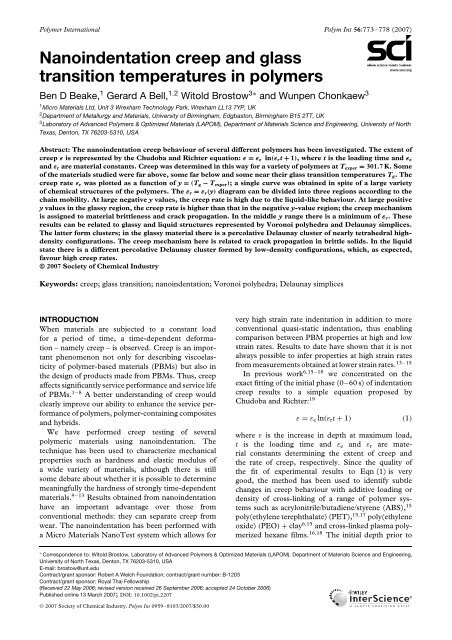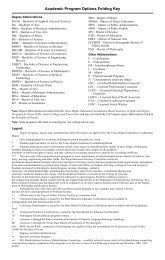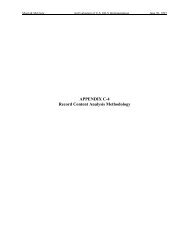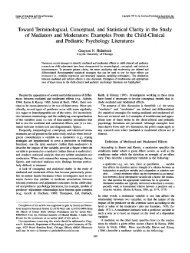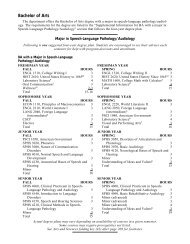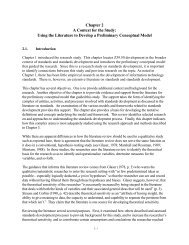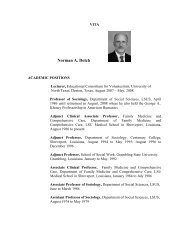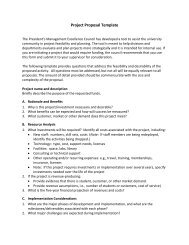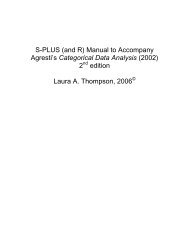Nanoindentation creep and glass transition ... - ResearchGate
Nanoindentation creep and glass transition ... - ResearchGate
Nanoindentation creep and glass transition ... - ResearchGate
Create successful ePaper yourself
Turn your PDF publications into a flip-book with our unique Google optimized e-Paper software.
BD Beake et al.the hold segment (see below) was kept constant bymeans of a depth-terminated nanoindentation loadramp.We know from the viscoelasticity theory that<strong>creep</strong>, including its time dependence, is controlledin polymeric materials by the free volume available formolecular (segmental) motions. 1–8 According to oneexplanation, around the <strong>glass</strong> <strong>transition</strong> temperatureT g heating creates sufficient free volume v f to allowmolecules to move relative to one another. 20 Asadvocated by Flory 21 <strong>and</strong> others, the free volumecan be calculated asv f = v − v ∗ (2)where v is the specific volume (usually in cm 3 g −1 )<strong>and</strong> v ∗ is the incompressible or hard core volumeobtainable from v(T, P) results via an equation ofstate such as that developed by Hartmann <strong>and</strong>Haque. 22 We postulated that a correlation betweenthe parameters in Eqn (1) <strong>and</strong> T g (a point representingthe <strong>glass</strong> <strong>transition</strong> region) would exist. We keep inmind that the location of T g is determined by v fchanges.EXPERIMENTALMaterialsMaterials selected were based on wide ranges of theirchemical structures, mechanical properties <strong>and</strong> a varietyof applications. Polystyrene (PS) was purchasedfrom Aldrich Chemicals Company. Santoprene ® wassupplied by Advanced Elastomer Systems, Houston,TX. Santoprene is a thermoplastic elastomer, containingethylene propylene diene monomer (EPDM)<strong>and</strong> polypropylene (PP) copolymer. Surlyn ® 8140 wassupplied by EI du Pont de Nemours, Wilmington,DE; it is a thermoplastic resin, an advanced ethylene/methacrylicacid (E/MAA) copolymer, in whichthe MAA groups have been partially neutralizedwith sodium ions. Polycarbonate (PC), acrylonitrilebutadiene-styrene(ABS) copolymer <strong>and</strong> polytetrafluoroethylene(PTFE) were supplied by Dow ChemicalCompany. PP was supplied by Phillips. Low-densitypolyethylene (LDPE) was supplied by Huntsman.Polyethersulphone (PES) was supplied by SolvayEngineered Plastics.<strong>Nanoindentation</strong> <strong>creep</strong> testingA NanoTest System manufactured by Micro Materialswas used for the nanoindentation <strong>creep</strong> testing;6,13 – 18the technique has been described previously.Briefly, the machine is a pendulum-based depthsensingsystem, with the sample mounted vertically<strong>and</strong> the load applied electromagnetically as shownschematically in Fig. 1. Current in the coil causes thependulum to rotate on its frictionless pivot so thatthe diamond probe penetrates the film surface. Weused a Berkovich-type three-sided pyramidal indenter,angle 65.3 ◦ , with an equivalent conical indenterFigure 1. Schematic of the NanoTest system.angle of 70.3 ◦ . The equivalent angle gives the samearea-to-depth ratio as the actual Berkovich indenter.Test probe displacement was measured with aparallel plate capacitor achieving sub-nanometreresolution. Indentations were load-controlled to 5mN maximum load at 0.2mNs −1 , followed by a 60 sholding period at this peak load for <strong>creep</strong> testing.Twenty tests were performed on each of the ninepolymer samples at various locations on the surface ofa given sample.Analysis methodologyAs already mentioned, Eqn (1) has been usedpreviously 6,15 – 18 to fit the <strong>creep</strong> behaviour <strong>and</strong> hasbeen found to indicate sometimes rather subtle differencesin the rate <strong>and</strong> extent of the time-dependentdeformation; ε e is interpreted as an extent term <strong>and</strong>ε r as a rate term. Normalizing, that is dividing ε e bythe initial deformation at the first indentation ε(0),provides a dimensionless parameter, ε e /ε(0), whichenables comparison of different materials. In our earlierwork, the initial deformation was set equal bymeans of a depth-terminated load ramp, although valuesof ε e /ε(0) themselves were not explicitly quoted.Somewhat similarly, Berthoud et al. 23 analysed thelogarithmic behaviour using an Eyring-type <strong>creep</strong> lawin terms of scalar stress <strong>and</strong> strain for a sphericalindenter. According to them, the fractional increase indepth (i.e. strain) ε/ε(0) isε/ε(0) = m eff ln(t/τ + 1) (3)where τ = 1/ε r = <strong>creep</strong> time <strong>and</strong> m eff = ε e /ε(0) =strain rate sensitivity. We have chosen to fit the first60 s of the experimental <strong>creep</strong> data to a modificationof Eqn (1) such that quantities on both sides aredimensionless:ε/ε(0) = [ε e /ε(0)] × ln(ε r t + 1) (4)774 Polym Int 56:773–778 (2007)DOI: 10.1002/pi
<strong>Nanoindentation</strong> <strong>creep</strong> <strong>and</strong> <strong>glass</strong> <strong>transition</strong> temperaturesMedvedev <strong>and</strong> Naberukhin 33 <strong>and</strong> called tetrahedricityT h . It can be calculated from the Delaunay simplexinformation asT h = ∑ i>j(l i − l j ) 2 /15〈l〉 2 (6)Figure 6. Voronoi–Delaunay tessalation for a set of points intwo-dimensional space.liquid <strong>and</strong> <strong>glass</strong>y phases. 28 This is based on a centuryoldapproach of the Ukrainian mathematician Hrihory(Georges in his papers written in French publishedin a German journal) Voronoi. 29,30 Consider a set ofpoints in space. For simplicity let us limit ourselves totwo dimensions. We draw lines connecting each pointto its nearest neighbours; these are the thin lines inFig. 6. The resulting structure is called the Delaunaysimplex.At the midpoint of each connecting line between anytwo points of the original structure a line is now drawnperpendicular to that connecting line (thick lines inFig. 6). For every point we use the perpendicularlines to create the smallest polygon surrounding thepoint. The polygon is an intersection of half-spaces (fordetails see either the original papers 29,30 or Brostow<strong>and</strong> Castaňo 27 ) <strong>and</strong> is called the Voronoi polygon. It isa dual structure with respect to the Delaunay simplex.In three dimensions we have the Voronoi polyhedrainstead of polygons. For a given set of points, thecomplete set of the polyhedra is called the Voronoidiagram. There are computer methods of generatingthe Voronoi diagram for a given set of points. 31,32Dealing with amorphous (<strong>glass</strong>y) or liquid materials,we find that the Voronoi diagram characterizes thematerial structure. The points correspond to atoms(in metals, or for instance in argon), to ions, or inpolymeric materials to single mers or to representative(statistical) mers. 21 The Voronoi diagram approachis applicable to any materials including crystals.However, in crystals the results are equivalent tothose given by classic crystallography. The connectionbetween the Delaunay figures (constituents of theDelaunay simplex in Fig. 6) <strong>and</strong> the crystal cells iseasy to see.Methods of characterization of structures by theVoronoi polyhedra rely on the size distribution ofthe polyhedra, distribution of the numbers of faces,distributions (or averages) of the face surface areas, etc.A useful measure of the structure has been defined bywhere l i is the length of the i-th simplex edge<strong>and</strong> 〈l〉 is the average edge length value in thematerial. According to Eqn (6), for T h = 0 we havea regular tetrahedron structure. Thus, the higher arethe values of T h , the larger are deviations from regulartetrahedricity.It has been demonstrated 33 that liquids (our ynegative) have monomodal histograms of relativefrequency of occurrence versus T h . There is apercolative cluster, with low local density <strong>and</strong> highmobility, going across the entire material. Thus, sucha cluster tends to be deformed easily <strong>and</strong> favours highε r . This situation corresponds to the left branch of thecurve in Fig. 5, with experimental points marked byasterisks.In the <strong>glass</strong>y phase (y positive), the liquid-likecluster is absent. 33 There is a marked minimum inthe histograms for T h ≈ 0.016. For T h < 0.016 thereis a different percolative cluster consisting of a nearlyregular tetrahedral configuration with high segmentaldensity. It seems plausible to assume that this T hregion corresponds in Fig. 5 to the central part of thediagram; it includes also some small negative y values.We are close to T g on either side of y = 0; T h is low, thetetrahedra nearly regular. For larger positive y valueswe see a jump to a higher ε r plateau. As already arguedabove, the mechanism of <strong>creep</strong> here is similar in natureto crack propagation in brittle solids.The present work is a part of a large programmeaimed at underst<strong>and</strong>ing the tribology of PBMs usinga variety of approaches. 34 – 37 The conclusions of thisstudy are also supported by results of nanoindentation<strong>creep</strong> tests at elevated temperatures. 38ACKNOWLEDGEMENTSPartial financial support was provided by the RobertA Welch Foundation, Houston (Grant B-1203) <strong>and</strong>also by the Royal Thai Fellowship, Bangkok (to WC)held at the University of North Texas.REFERENCES1 Ferry JD, Viscoelastic Properties of Polymers. Wiley, New York(1980).2 Brostow W (ed.), Failure of Plastics. Hanser, Munich/New York(1986, 1989, 1992).3 Nielson LE <strong>and</strong> L<strong>and</strong>el RF, Mechanical Properties of Polymers<strong>and</strong> Composites. Marcel Dekker, New York (1994).4 Goldman AY, Prediction of Deformation Properties of Polymeric<strong>and</strong> Composite Materials. American Chemical Society, Washington,DC (1994).5 Mazur S, in Polymer Powder Technology, ed. by Narkis M <strong>and</strong>Rosenzweig N. Wiley, Chichester/New York, chap. 8 (1995).6 Beake BD, Chen S, Hull JB <strong>and</strong> Gao F, J Nanosci Nanotech 2:73(2002).Polym Int 56:773–778 (2007) 777DOI: 10.1002/pi
BD Beake et al.7BrostowW,Mater Res Innovat 3:347 (2000).8BrostowW (ed.), Performance of Plastics. Hanser, Munich(2000).9 Oliver W <strong>and</strong> Pharr G, JMaterRes7:1564 (1992).10 Rau K, Singh R <strong>and</strong> Goldberg E, Mater Res Innovat 5:151(2002).11 Tho KK, Swaddiwudhipong S, Lui SZ, Zeng K <strong>and</strong> Hua J, JMater Res 19:2498 (2004).12 Alkorta J, Martines-Esnaola JM <strong>and</strong> Gil-Sevillano J, JMaterRes20:432 (2005).13 Beake BD, Zheng S <strong>and</strong> Alex<strong>and</strong>er MR, JMaterSci37:3821(2002).14 Beake BD <strong>and</strong> Leggett GJ, Polymer 42:319 (2002).15 Beake BD, Leggett GJ <strong>and</strong> Alex<strong>and</strong>er MR, JMaterSci37:4919(2002).16 Beake BD, Goodes SR, Smith JF <strong>and</strong> Gao F, JMaterRes19:237(2004).17 Juliano TF, VanL<strong>and</strong>igham MR, Tweedie CA <strong>and</strong> Van Vliet KJ,Exp Mech, DOI: 10.1007/s11340-006-8276-5.18 Tweedie CA <strong>and</strong> Van Vliet KJ, JMaterRes21:1576 (2006).19 Chudoba T <strong>and</strong> Richter F, Surf Coat Technol 148:191 (2001).20 Painter PC <strong>and</strong> Coleman MM, Fundamentals of Polymer Science.Technomic, Lancaster, PA (1994).21 Flory PJ, Selected Works, vol. III. Stanford University Press,Stanford, CA (1995).22 Hartmann B <strong>and</strong> Haque M, J Appl Phys 58:2831 (1985).23 Berthoud P, G’Sell C <strong>and</strong> Hiver JM, J Phys D 32:2923(1999).24 Beake BD, JPhysD39:4478 (2006).25 Brostow W, Cunha AM, Quintanilla J <strong>and</strong> Simões R, MacromolTheory Simul 11:308 (2002).26 Brostow W <strong>and</strong> Simões R, J Mater Ed 27:19 (2005).27 Brostow W <strong>and</strong> Castaňo VM, J Mater Ed 21:297 (1999).28 Medvedev NN, Geiger A <strong>and</strong> Brostow W, J Chem Phys 93:8337(1990).29 Voronoi G, JReineAngewMath134:198 (1908).30 Voronoi G, JReineAngewMath136:67 (1909).31 Brostow W, Dussault J-P <strong>and</strong> Fox BL, J Comput Phys 29:81(1978).32 Brostow W, Chybicki M, Laskowski R <strong>and</strong> Rybicki J, Phys RevB 57:13441 (1998).33 Medvedev NN <strong>and</strong> Naberukhin YI, J Non-Cryst Solids 94:402(1987).34 Brostow W, Bujard B, Cassidy PE, Hagg HE <strong>and</strong> MontemartiniPE, Mater Res Innovat 6:7 (2002).35 Brostow W, Damarla G, Howe J <strong>and</strong> Pietkiewicz D, e – Polymers025:1 (2004).36 Bermudez MD, Brostow W, Carrion-Vilches J, Cervantes JJ,Damarla G <strong>and</strong> Perez JM, e – Polymers 003:1 (2005).37 Brostow W, Chonkaew W <strong>and</strong> Menard KP, Mater Res Innovat(in press).38 Beake BD <strong>and</strong> Gray A, in preparation.778 Polym Int 56:773–778 (2007)DOI: 10.1002/pi


